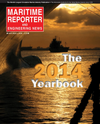
Page 42: of Maritime Reporter Magazine (June 2014)
Annual World Yearbook
Read this page in Pdf, Flash or Html5 edition of June 2014 Maritime Reporter Magazine
42 Maritime Reporter & Engineering News • JUNE 2014 that eventually became the rule interna- tionally, especially following several oil spills in European waters. OPA greatly increased federal oversight of maritime oil transportation, toughened liabil- ity and provided greater environmental safeguards. It also put the spotlight on drug abuse in the merchant marine and led to related programs and reforms.
Rounding out the list of accidents that spurred calls to action and helped to write the book on maritime safety are the following: • The Argo Merchant: In December 1976, the Liberian ? agged tanker ran aground in Nantucket, Mass., resulting in the worst U.S. oil spill (7.6 million gallons) up to that date. According the
Coast Guard, the cause was the result of ineffective vessel navigation due to faulty gyrocompass, erratic RDF and human error in the ineffective use of standard and secondary navigation – ex- acerbated by a winter storm.
The spill led to the creation of the Port and Tanker Safety Act of 1978, which established vessel traf? c services, pro- vided for greater supervision and control of vessels in U.S. waters, and instituted an inspection program for tank vessels carrying oil and hazmat. It also helped lead to the development and adoption of
MARPOL Annex 1, and led to a host of new CFR regulations in the U.S., includ- ing for radar requirements depth ? nders and required pre-arrival navigation tests. • The SS Yarmouth Castle: The
Panamanian-? agged, largely wood ves- sel caught ? re on Nov. 13, 1965, and was quickly abandoned by most of her crew, resulting in 90 deaths. No alarm was sounded, no distress call sent out, nor did the sprinklers work, the win- dows open, nor were all the lifeboats ac- cessible. Less than half were launchable and the master and crew were the ? rst to abandon ship. It led to a major update of SOLAS, and a mandate that any ves- sel carrying 50 overnight passengers or more had to be built entirely of noncom- bustible materials or steel. Retroactive ? re and safety amendments went into ef- fect for all ships in 2010. • The MS Estonia: The RoRo Ferry sank in heavy seas Sept. 28, 1994 in cir- cumstances very similar to the Herald of
Free Enterprise – in this case the bow door failed, letting in too much water, sinking the boat, and killing 852 people out of the 1,000 on board. To improve the survivability of ferries, it also led to changes in the design parameters so that ferries can take up to a half meter of wa- ter on the car deck before the ship starts to list. • Prestige (2002) and Erika (1999):
Both casualties and spills happened in almost the same spot off the northwest coast of France and Spain, and both became a huge political issue, leading to Eur-OPA, the European equivalent of OPA90 “It was the ? nal nail in the cof? n,” says Simon Bennett, Director
External Relations for the International
Chamber of Shipping (ICS), an inter- national trade association for the ship- ping industry representing ship owners and operators. Those incidents “led to a massive acceleration of the schedule to phase out single-hulled tankers.” “Blame the captain and fi re that person. I always cringe when I see that, it’s just the easy way out. Seafarers want to do better, they don’t want to go to work and cause accidents.”
Tim Donney, global head, marine risk consulting, Allianz Global Corporate and Specialty
THE 2014 YEARBOOK: MR 75TH ANNIVERSARY
Prestige was a driver for the creation of “Eur-OPA”.
Inset Photo: U.S. Coast Guar d Ar chives
MR #6 (40-49).indd 42 5/29/2014 9:25:36 AM

 41
41

 43
43
